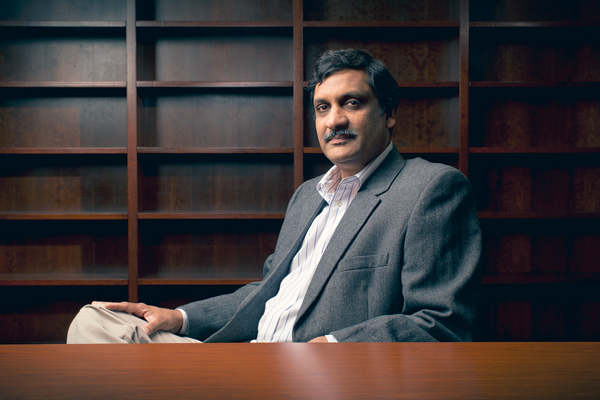With EdX, School’s Out—Forever

EdX president Anant Agarwal hopes the higher-ed program will one day reach a billion students. (Photo by Scott M. Lacey)
When I visit the edX headquarters in June, I find a bland, brick office building across from the MIT campus. The modest office suite feels appropriate for a startup: fresh white paint, a tiny kitchenette stuffed with boxes, and a conference room with wall-to-wall built-in bookshelves, all of them empty. The glass walls of the 15 interior offices are covered with equations and ideas written in felt-tipped pen, serving as whiteboards until the real things arrive. Oddly, there are hardly any computers in sight.
In a bare corner office sits Agarwal, who was named president of edX in May. He grew up in India and attended the Indian Institute of Technology Madras, where he earned his bachelor’s degree. He went on to receive a Ph.D. in electrical engineering from Stanford, has taught electrical engineering and computer science at MIT since 1988, and has cofounded five startups in the computer design industry. Agarwal tells me that he’s passionate about edX’s mission of educating the world because he understands how precious access to advanced learning can be. Higher education remains limited in India, he explains, and he was fortunate to be able to go to college himself. Online learning, he says, has already opened up opportunities for people living in poor communities with limited access to universities. “Suddenly with edX,” he says, “you can improve that 10-fold.”
Online classes are hardly new, of course. The University of Phoenix has been offering Web-based bachelor’s and post-grad programs since 1989. The for-profit company is based on the interesting proposition that you don’t need to sit through lectures in a building draped with ivy, because everything you need to know can be taught over the Internet. In 2010, more than 600,000 students took classes through the school.
MIT began contemplating a massive online class in 2007. Then-provost L. Rafael Reif, who was named the Institute’s president in May, saw that students were using the Internet in nearly every part of life, yet classroom learning remained relatively untouched by the Web. So he set up several committees dedicated to thinking about how online technology should remake the way students learn, and how that technology could be shared with the world. Professors played with different techniques for ?four years, and in 2011 Reif finally unveiled MITx to faculty, alumni, students, and trustees. Agarwal quickly volunteered to put his full circuits course online.
In the old days—like, a year or two ago—online learning consisted of students sitting in front of computers watching hour-long videos of professors droning on from behind a lectern. If you were lucky, somebody might post a PowerPoint presentation. That model is dead.
At edX, lectures are chopped up into short, digestible snippets, which run anywhere from three to 15 minutes. Typically, there are two lectures a week, with each lecture containing anywhere from five to 20 video snippets. Onscreen, you never see the professor. Instead, words or formulas appear on a blackboard as the professor’s voice guides you through the lesson with a transcription of the lecture also running on the screen. Quizzes, homework assignments, and labs—which use a “virtual sandbox” that lets students build electrical circuits as realistically as if their hands were touching actual copper wires—are interspersed throughout the course.
If you get an answer wrong or don’t understand something, you can rewind the lesson (they’re “on demand”) and watch it again. Students must complete the work on deadline, and since everything is auto-graded, feedback is instantaneous. Typical classes run for six to 12 weeks, and though advanced students can skip only so far ahead for now, that may change in the future. Unlike previous online models, edX connects pupils and professors through discussion forums and chat rooms, enabling students to “socialize” and help one another learn. At the end of the course, if you’re successful and pass the final exam, the university gives you a certificate. You’re considered competent in that subject matter. Currently, the certificate is free, but edX could charge for it in the future.
David Ku, who was a senior at MIT last semester, needed to take the circuits class to graduate with a degree in electrical engineering and computer science. He decided to try the online version. Ku says the virtual edX labs “were the most powerful component” of the experience. “You put together wires and tubes online, measure voltages and currents exactly like I would’ve in class.” He also appreciated having instant access to his grades, rather than waiting a week for a teaching assistant to mark up and return his homework. With online learning, he says, he could move at his own speed. It was a new way of taking classes and learning, and he says he loved it.